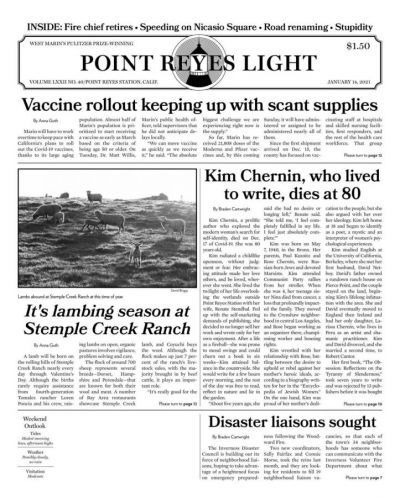Keepers of the Light — West Marin publishers shepherd the Point Reyes Light and assume their place in its storied history
Teri Saylor
Special to Publishers' Auxiliary
Sep 1, 2021


Some community publishers fashion their newspapers to mirror their communities. Some view their papers as cheerleaders. Others are crusaders. And there are publishers who use their newspapers as their own bully pulpit. Over the course of the Point Reyes Light’s 73-year storied history, it has filled all those roles, and more.
As traditional newspaper publishing becomes more challenging, the current owners, Tess Elliott and David Briggs, are building upon the newspaper’s colorful legacy as they continuously seek better ways to serve the northern California region they cover and provide readers with the news and information they need.
In 2006, Elliott arrived in western Marin County, California. She had visited a few times and fell in love with the region’s wild and beautiful coastline along the Point Reyes National Seashore. In 2007, she was hired on at the Point Reyes Light, starting out in advertising and later becoming editor.
At the time, the newspaper was owned by a former Monterey prosecutor, Robert Plotkin, who introduced a sensational style of reporting to the small coastal communities that were used to traditional newspaper coverage, Elliott said in a Zoom interview alongside her life partner and co-publisher Briggs. Plotkin, with a master’s degree in journalism from the University of Missouri, had lofty journalism ambitions that were not a good fit with readers in the small communities the newspaper served.
“He came in as an outsider and wasn’t covering local news or the issues that matter to people,” Elliott said. “He was doing sensational coverage, and the newspaper was struggling.”
That coverage opened the door to competition.
The same year that Elliott became editor at the Point Reyes Light, a second newspaper — the West Marin Express — was circulating in West Marin County, serving up conventional community news. For eight years, the two went head-to-head, competing for readers and advertising.
In 2010, a group of people in the community formed the Marin Media Alliance, a low-profit limited liability company (L3C), and purchased the Light from Plotkin. Elliott stayed on as editor, and in 2015, she assumed the business and converted it to an LLC. That same year, Elliott and Briggs bought the Marin County Express, folded it into the Light and restored typical community journalism back to their readers.
The journey hasn’t been easy.
“We’re making it right now,” Elliott said. “No one earns much money, but we’re paying our bills. We rely on a very small base of advertisers, and that’s where we derive the majority of our income. I think our revenue is at 75% advertising, 25% subscriptions and single-copy sales.”
The Point Reyes Light covers about a dozen unincorporated communities along the western Marin County Coastline, a sparsely developed region and home to the Point Reyes National Seashore. It’s the kind of place where one must work hard to build and maintain connections. For Elliott, it was challenging at first to cover such a spread-out, rural region, but after getting to know the communities and the residents, it got easier, she said.
“We know so many people now, and we hear about things that are happening,” she said. “In the beginning, when I started, it was about grasping for ideas, but now we are more aware of what is going on, and we’re never short of things to write about.”
The West Marin region is an eclectic mix of ranchers, artists, small businesses and service workers. Aging hippies, carry-overs from the ‘60s counterculture movement and the Summer of Love, still hang on in the region’s nooks and crannies. West Marin is a sliver along the coastline of one of the wealthiest counties in the United States. According to the U.S. Census, Marin County had a population of 247,289 in 2020, with a median family income of $88,934.
The region is facing environmental issues brought about by sea-level rise and dwindling water supplies, Briggs said. Affordable housing is also a major issue in the area, and the Point Reyes National Seashore is often the subject of land management controversies, the most recent being a profitable, family owned oyster farm managed at the National Seashore for decades until its permit expired.
In 2011, Drake’s Bay Oyster Company, located just inside the Point Reyes National Seashore boundary, faced a crisis. For nearly a half-century, the family-owned business had a permit to raise and sell oysters from the National Park Service and had become one of the largest shellfish producers in California. But the National Park Service did not extend the farm’s permit, setting the stage for a battle that pitted sustainable food advocates and local economy boosters against environmentalists and wilderness supporters. It was a contentious subject for area newspapers to cover, too. The upstart West Marin Express and the Point Reyes Light came down on opposite sides, with the Light editorially supporting the oyster farm.
The newspaper faced criticism for how it reported the news, and today, Elliott is still reticent about writing editorials that take stands on issues, yet, she runs a lively editorial page featuring letters to the editor and guest opinion columns.
“We are sensitive to publishing divisive opinions, and we’ve made it a point to be careful about what we say, so we’re not writing editorials every week, shooting things down or propping things up,” she said. “But that doesn’t mean we are not providing hard facts. We are just careful about how we present them. Our priorities are to the facts out there, inform people and provide a forum for them to talk with each other.”
The Point Reyes Light, founded as The Baywood Press in 1948 by Dave and Wilma Rogers, has gone through many ownerships and changes. In 1966, the owners, Don and Clara DeWolfe, re-named the newspaper Point Reyes Light after the famous Point Reyes Lighthouse.
For nearly 30 years, the newspaper was printed on a 1910 flatbed-Goss press. When Dave and Cathy Mitchell bought the newspaper in 1975, they converted production to offset printing, ushering in a modern era for the newspaper.
In 1979, the Light won the Pulitzer Prize for Meritorious Public Service for an exposé of Synanon Incorporated, a onetime drug-rehabilitation program that became a violent cult. Synanon was infamous for attempting to murder a Los Angeles attorney by planting a rattlesnake in his mailbox.
Later, Mitchell received national recognition again for extensive reporting on immigration.
The Mitchells divorced in 1981 and sold the newspaper. But Dave Mitchell acquired it again in 1983 ran it for more than 20 years before selling it to Plotkin in 2005.
Today, the Point Reyes Light has become renowned for its sheriff’s blotter column, which Slate magazine has dubbed “the best police blotter in America.”
The Sheriff’s Calls is a slice of life, parsed in simple sentences that are storytelling at its finest. Case in point: “On August 16 in Marshall at 7:37 p.m. a woman reported a lost dog: a black, one-eyed Mexican hairless rescue that is friendly to women but afraid of men.”
On a day-to-day basis, Elliott and Griggs have a clean division of responsibilities. Elliot manages the newspaper’s two reporters, interfaces with the community, manages the calendar and write’s the Sheriff’s Calls column.
Griggs manages the business side of operations, handles graphic design and does all the photography.
The two focus on bread-and-butter coverage that serves to keep readers informed in an unusual era where facts are sometimes distorted and the public generally distrusts the media.
“We feel that we provide a really important balance by having a carefully edited paper where we take the time to work with letter writers and op-ed contributors to be very conscientious about facts,” Elliott said. “We are a paper that engages with everyone, welcomes everyone’s voice and carries on an important tradition.”
Elliott and Briggs are parents to two young children, juggling homeschooling with their duties as newspaper owners. They also operate out of a newspaper office in Inverness.
Neither Elliott nor Griggs is from California. Elliott grew up in Oregon and went to school in Colorado. Griggs hales from Louisiana. Neither has a background in journalism but are astute businesspeople who have worked hard to keep the newspaper profitable and valuable to their community.
They employ two full-time writers and rely on freelancers from the community. They also have an advertising sales staff of one.
The newspaper is published on Thursdays with print circulation of 2,000, a digital circulation of around 500 and about 4,000 visitors to the website each week. Its top challenges are finding good writers and getting the newspaper printed, Briggs said.
Briggs and Elliott plan to continue printing until there are no other options.
“I think it would be hard to accommodate a 100% digital product and continue to operate the business even remotely the same way it’s operated now,” Briggs said.
The newspaper is distributed through the post office, on racks and in convenience stores.
In addition to the Point Reyes Light, they publish a literary travel magazine called the North Coaster, which is filled with photos, essays and poems about the highways, byways and iconic businesses along the northern shore of Marin County.
For the couple, owning and running a community newspaper has come with a steep learning curve, but it is one they’re willing to climb. Elliott continues to be excited about small gains.
“I go through ups and downs, and sometimes I think what we’re putting out is terrible, but other times I’m pretty impressed with what we’re able to do and how we pull it off,” she said. “It’s a beautiful paper, and it’s really good quality. It blows me away sometimes.”
In many ways, Elliott and Briggs feel that they are stewards of the newspaper more than business owners. The Light’s long and colorful history and its Pulitzer Prize has instilled in them a sense of duty, as if they are managing a sacred trust until the day comes that they hand it off to a new generation of publishers.
“We absolutely feel an obligation to keep this newspaper alive,” Briggs said. “We feel fortunate and lucky to be its stewards.”
Teri Saylor is a writer in Raleigh, North Carolina. Contact her at terisaylor@hotmail.com







